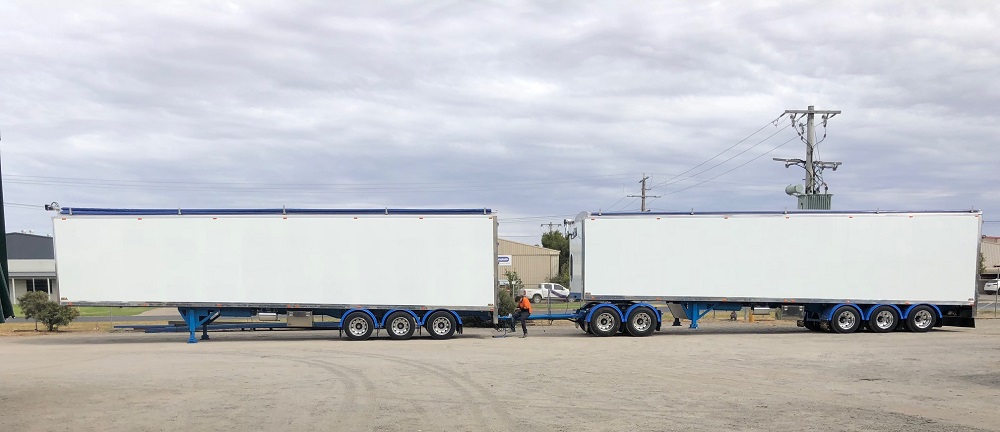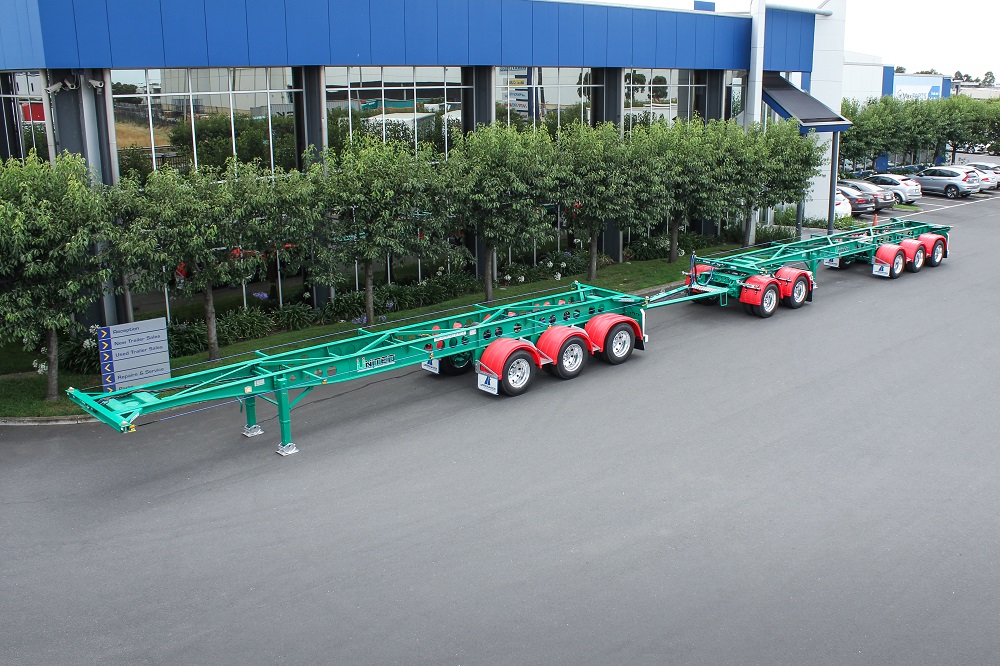Here’s why 34-metre A-doubles have become a thing
Q: How long is an A-double?
A: Well, it depends…
An A-double is any heavy vehicle combination featuring a prime mover towing two semi-trailers that are connected to each other by a converter dolly. ‘A’ signifies a converter dolly coupling, as opposed to ‘B’ which signifies a direct piggy-back fifth-wheel coupling, as in a B-double.

So back to our question: How long is an A-double?
Sometimes it’s 36.5 metres
A conventional A-double, sometimes referred to as a Type I road train or simply a double road train, is an as-of-right combination confined to a prescribed 36.5-metre road network that services only the more remote areas of Australia. This combination has been around for many years.
Sometimes it’s 27.5 metres
In Western Australia, B-doubles operate on a 27.5-metre road network, as opposed to the 26-metre road networks elsewhere. This length was chosen for B-doubles in Western Australia to allow long-wheelbase prime movers with big sleeper cabs and plenty of fuel capacity. The 27.5-metre ‘pocket’ road train also operates on this network, which provides much better access than the 36.5-metre network.
Sometimes it’s 30.0 metres
When PBS was introduced in 2007, so was the concept of a ‘Level 2B’ road network that allows PBS-approved Level 2 combinations up to 30.0 metres long. Online maps of the Level 2B road network have developed gradually over the past 10 years, focusing on access between the 36.5-metre road train network and container ports. The most popular use for 30-metre A-doubles is 40-foot shipping container transport, where productivity doubles instantly.
Sometimes it’s 26.0 metres
While there’s not much of a pre-approved road network for 30.0-metre combinations, requiring last-mile access approval in most cases, there’s quite a large 26-metre road network in the eastern states, particularly in Victoria. This network is intended for B-double use. Provided the infrastructure is capable of carrying the additional mass, as determined by the road manager, a PBS-approved Level 2A 26-metre A-double can access parts of the 26-metre road network. The 26-metre envelope is limited to higher-density bulk commodities like fuel and grain, which can easily adapt to the reduced length.
Which brings us to 34.0 metres (or thereabouts)
In Advantia’s experience there have been two reasons for clients to adopt a 34-metre (or thereabouts) overall length for a PBS-approved A-double. In all cases this has been facilitated by Victoria’s pragmatic approach to combination length, where combinations satisfying PBS Level 2 standards can typically be approved despite exceeding the nominal 30-metre Level 2B envelope.
The most obvious reason is to be able to use longer trailers to get more volume onboard. For example, two 45-foot trailers as shown in the PBS-approved combination below.

This combination, which hauls a very light bulk commodity, has approval to operate between the New South Wales road train network and various sites in Victoria, including metropolitan Melbourne, at a low Gross Combination Mass.
Another reason is to achieve a higher Gross Combination Mass. The most critical dimension of an A-double, in terms of the amount of mass that a road manager may grant, is the drawbar length. Specifically, it is the clear space between the axles of the first trailer and those of the converter dolly. By making this distance greater, a greater Gross Combination Mass can be granted. Although it’s not necessary to exceed 30.0 metres to fit two 40-foot shipping containers on an A-double, if you want them to carry a high mass you may need to increase that clear space. The example below, built to carry two 40-foot shipping containers, achieved more than 80.0 tonnes Gross Combination Mass on an approved route that would have offered much less at 30.0 metres overall length due to ageing infrastructure constraints.

It should be noted that once an A-double exceeds 30.0-metres overall length, it becomes necessary to consider the use of steerable rear axles on the trailers to ensure that the combination continues to satisfy all PBS standards, particularly Low Speed Swept Path (the amount of cut-in when turning).
Advantia can design an A-double to not require steerable axles, but this may compromise the design intent, which may be to achieve a certain amount of volume or a certain bridge loading outcome.
Contact Advantia if you would like to investigate A-double opportunities for your business.
Get more like this in your inbox
Subscribe to our Newsletter and never miss a post.